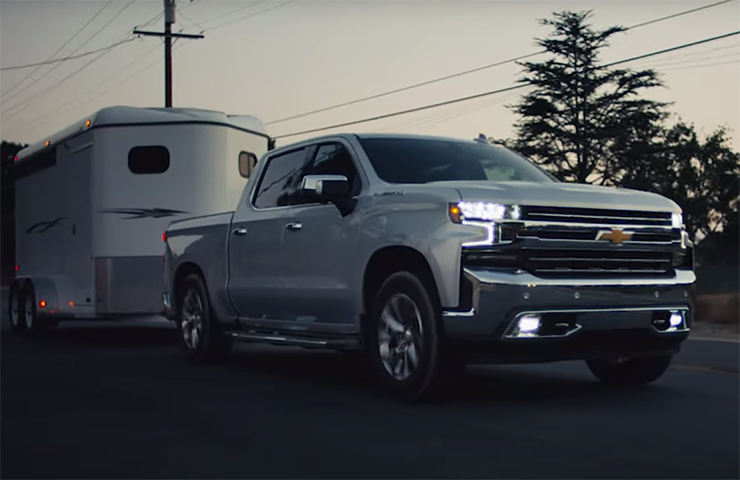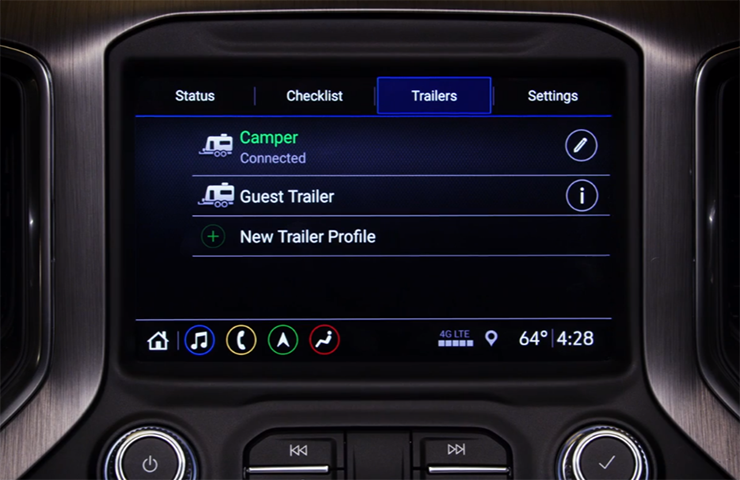If the trailer lighting on customers’ trailers connected to some 2019-2020 Silverado and Sierra models does not operate as expected, such as inoperative lighting, improper trailer detection, or intermittently flashing lights with the vehicle off, the cause may be related to either the trailer or the truck. (Fig. 11) Proper diagnosis requires determining the operation of the trailer wiring as well as the components on the truck.
 Fig. 11
Fig. 11
2019-2020 Silverado and Sierra models equipped with the in-vehicle trailering app (Trailer Information Indicator, RPO U1D) (Fig 12) use the K68 Trailer Lighting Control Module to control all trailer lighting as well as additional features like trailer detection, trailer theft alert and trailer lighting circuit diagnostics, such as trailer bulb out detection and over-current.
 Fig. 12
Fig. 12
2019 vs. 2020 Models
2019 models with RPO U1D control trailer lighting through pulse width modulated (PWM) voltage. The trailer park and stop/turn signal lamp control circuits must draw at least 55mA of total current to be detected as a trailer or the Trailer Lighting Control Module will not control the lighting circuits to the trailer.
2020 models with RPO U1D control trailer lighting through pulse width modulated (PWM) voltage to the stop/turn signal and backup lamps only. The park lamps use an internal printed circuit board (PCB) relay to control the park lamp circuit, which enables additional output current for the park lamps. As on the 2019 models, the trailer stop/turn signal lamp control circuits must draw at least 55mA of total current to be detected as a trailer or the Trailer Lighting Control Module will not control the lighting circuits to the trailer.
Flashing Trailer Lights
One lighting issue that may concern customers is how often the trailer lights flash as part of the trailer detection and/or trailer theft features. The Trailer Lighting Control Module periodically pulses the lighting circuits of the trailer to verify it is still connected when the vehicle ignition is off.
If the periodic trailer light flashing when the vehicle is parked is objectionable to a customer, refer to Bulletin #20-NA-198 for information on a calibration update to the Trailer Lighting Control Module. After the update is completed, the trailer lights will only flash once every 42 minutes when the trailer theft feature is turned off. If the trailer theft alert is on in the trailer app settings (Fig. 13), the timing of the trailer light flashing will not change as the system needs to continuously monitor the trailer connection.
 Fig. 13
Fig. 13
Trailer Simulator Test Tool
To determine the proper operation of the Trailer Lighting Control Module, connect the EL-52641 Trailer Simulator Test Tool (Fig. 14) to the truck’s 7-way connector. The Trailer Lighting Control Module will detect the test tool and enable the trailer lighting outputs. With the tool connected, turn on the vehicle ignition to operate all the lights: park, LT/RT turn, stop and reverse. If the lights on the test tool illuminate in correlation with the lights on the vehicle and there are not any DTCs or warning messages displayed on the Driver Information Center (DIC), the truck is operating as designed and no repairs should be performed to the components on the truck.
 Fig. 14
Fig. 14
TIP: When the vehicle ignition is turned off while the Trailer Simulator Test Tool is connected, the trailer lighting LEDs on the tool may flicker/flash randomly. This is normal and is part of the Trailer Lighting Control Module’s trailer detection/trailer theft feature.
Trailer Wiring
A trailer that has wiring that is in very poor condition may result in several DTCs set against the trailer lighting circuits along with DIC warning messages. In some cases, the poor wiring may even open the Trailer Lighting Control Module fuse F74UA or F82UA on the vehicle. If this occurs, verify that the customer’s trailer wiring (if available) is in good working condition. If the truck functions properly after using the Trailer Simulator Test Tool, the cause rests with the trailer. Trailer-related lighting issues are not covered under warranty.
Here are some tips that may help the customer/trailer supplier understand and correct any trailer-related issues.
- Some trailers use a trailer-mounted control module to operate some or all of the trailer lights. These trailers may use the B+ circuit from the trailer connector to power the trailer lighting circuits. These trailers may not always be detected by the Trailer Lighting Control Module and may set faults. Load resistors could be added in parallel to the detectable lighting circuits of the trailer to increase current draw. Another option is to rewire the trailer to eliminate the trailer-mounted control module and have the circuits wired directly to the trailer lamps.
- Some non–DOT approved LED lamps may not draw enough current for the Trailer Lighting Control Module to detect a trailer when connected and, as a result, the Trailer Lighting Control Module will not enable the lighting circuits to the trailer. Changing one or more trailer lamps on the detectable circuits to incandescent bulbs or DOT-approved LED lamps will increase current draw while maintaining full functionality of the Trailer Lighting Control Module. Adding a load resistor in parallel to the detectable lighting circuits of the trailer also will increase current draw.
- Some aftermarket accessories, such as trailer-mounted cameras, are incompatible with PWM voltage and may not function correctly when connected to the trailer lighting circuits of the vehicle. The lighting control circuits can be wired to control a relay, in which the relay will provide stable voltage to the customer’s aftermarket accessory.
Refer to #PIT5747A and Bulletin #20-NA-198 for additional information on trailering lighting.
– Thanks to Kevin Minor


















